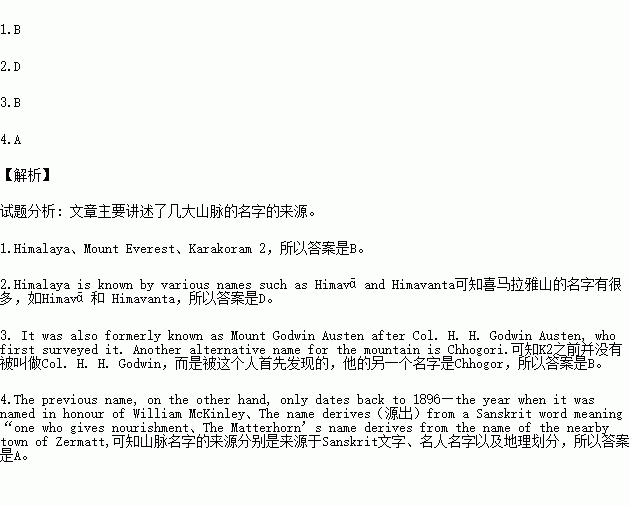题目内容
阅读下列短文,从每题所给的四个选项(A、B、C和D)中,选出最佳选项,并在答题卡上将该项涂黑。
In August 2015, President Obama announced that North America’s highest mountain, Mount McKinley, would be renamed. Its new moniker(名字), Denali, was actually its original Aleut name, meaning “the high one”. The previous name, on the other hand, only dates back to 1896—the year when it was named in honour of William McKinley(1843—1901), who was shortly to become President of the United States. Denali is of course not the only mountain with an interesting linguistic history, so let’s travel to Asia, and across Europe, to explore the naming of those continents’ most famous peaks and mountain ranges.
The Nepalese name Himalaya comes from a Sanskrit word meaning “Abode of Snow”, from hima for “snow” and ālaya for “abode”. In Buddhist sources, Himalaya is known by various names such as Himavā and Himavanta.
In 1856, Mount Everest was named after Sir George Everest (1790—1866), who was the superintendent (负责人)of the Trigonometrical Survey of India. Everest himself was initially displeased by the naming, since he feared that local inhabitants might not be able to pronounce it.
K2 stands for Karakoram 2, because it was the second peak to be surveyed in the Trigonometrical Survey in the Karakoram system. It was also formerly known as Mount Godwin Austen after Col. H. H. Godwin Austen, who first surveyed it. Another alternative name for the mountain is Chhogori.
Annapurna is a household Goddess for Hindus, who guarantees to her worshippers (崇拜者)that food will not fail. The name derives(源出)from a Sanskrit word meaning “one who gives nourishment”.
The Matterhorn’s name derives from the name of the nearby town of Zermatt, the second element of which is apparently Matte “meadow”, and Horn, “horn”. Horn is not an unusual element in German names of mountains with jutting(突出的)peaks. The mountain is called Mont Cervin in French and Monte Cervino in Italian, from the Italian adjective cervino “deer-like”, which conjures up (使想起)a deer’s antlers.
Ben Nevis is the Anglicized form of the Scottish Gaelic name Beinn Nibheis, which means“Mountain by the(River)Nevis”. The name of the river apparently derives from a Celtic root for “water”.
1.How many continents’ mountains are mentioned in the passage?
A. 2 B. 3
C. 4 D. 5
2.Himalaya is a mountain also named ________.
A. Nepalese B. Abode of Snow
C. Alaya D. Himavā
3.Which of the following is FALSE according to the passage?
A. Everest was unhappy about the name of Mount Everest at first.
B. K2 was once called Col. H. H. Godwin.
C. Annapurna means “one who offers food”.
D. Matterhorn comes from the name of the nearby town of Zermatt.
4.The above mountains’ names come from sources other than _________.
A. color B. a Sanskrit word
C. a person’s name D. geographic name
 阳光试卷单元测试卷系列答案
阳光试卷单元测试卷系列答案
